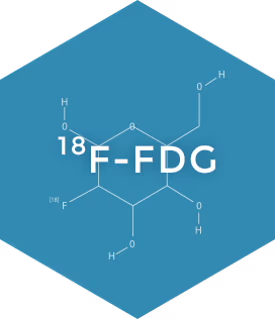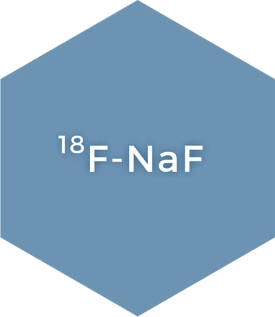¹⁸F-FDG
18F-FDG (Fluorodeoxyglucose) is a glucose analogue which accumulates in tissue in proportion to the amount of glucose utilization. Increased consumption of glucose is characteristic of most cancers and is mostly related to overexpression of the GLUT glucose transporters and increased hexokinase activity. Once inside the cell, FDG is phosphorylated by the enzyme hexokinase and trapped.
18F-FDG PET/CT has become one of the cornerstones of patient management in oncology.
Indications for 18F-FDG PET/CT include, but are not limited to, the following:
- Differentiation between benign and malignant lesions;
- Screening for an unknown primary tumor when metastatic disease is discovered as the first manifestation of cancer or when the patien presents with a para-neoplastic syndrome;
- Initial staging patients with known malignancies;
- Distinguishing residual active tumor from post-treatment fibrosis or necrosis;
- Detecting tumor recurrence (restaging), especially in the ;presence of elevated tumor markers;
- Selection of a metabolically active region within a tumor most likely to yield diagnostic information for biopsy;
- Guiding radiation therapy planning.

¹⁸F-NaF
18F-NaF (Radio-Flu) is a radioactive diagnostic agent for positron emission tomography (PET) indicated for imaging of bone to define areas of altered osteogenic activity.
Because of its binding to bone mineral, 18F (sodium fluoride) is taken up 3-10 times more in bone regions affected by malignant processes with resulting osteoblastic activity or osteolytic defects than in unaffected adjacent bone. Non-cancerous traumatic, erosive or inflammatory lesions of bone structure are also associated with increased osteogenesis. Sodium fluoride (18F) is therefore a marker of the reactive bone processes of cancerous or traumatic conditions. It also detects nonmalignant regions of physiologically or pathologically increased bone metabolism.

Radelumin (¹⁸F-PSMA-1007)
Radelumin (18F-PSMA-1007) is a radioactive diagnostic agent used for Positron Emission Tomography (PET).
It helps in imaging prostate-specific membrane antigen (PSMA)-positive lesions in adult patients. This is particularly useful for suspected recurrence of prostate cancer after primary curative therapy, based on increasing serum prostate-specific antigen (PSA) levels. Additionally, it is also used for the primary staging of patients with high-risk prostate cancer prior to primary curative therapy. See SmPC for the full indication and product information (https://abx.de/products/medicinal-products/product-information-radelumin-1).
Radelumin contains 18F-PSMA-1007 as the active substance and is administered by intravenous injection.
Availability: Radelumin is available on Monday, Wednesday, Thursday, and Friday.

NeuraCeq (¹⁸F-Florbetaben)
NeuraCeq (18F-Florbetaben) is a radioactive diagnostic agent for Positron Emission Tomography (PET).
NeuraCeq is used during brain scans in patients with memory problems to see whether or not they have significant amounts of β-amyloid plaques in the brain. β-amyloid plaques are deposits sometimes present in the brain of people with memory problems caused by dementia (such as Alzheimer’s disease, Lewy-body dementia and Parkinson’s disease dementia) and also in the brain of some elderly people with no symptoms.
If few or no β-amyloid plaques are seen in the PET scan (a negative scan), the patient is unlikely to have Alzheimer’s disease. However, a positive scan on its own is not sufficient to make a diagnosis in patients with memory problems, as plaques may be seen with several types of dementia and also in some elderly people with no symptoms. Doctors will therefore need to use the scans together with clinical evaluation.

¹¹C-tracers
Due to the short half-life (20 minutes) of 11C (carbon-11), it has to be produced on location.
11C tracers are mainly used in preclinical and clinical PET-studies for the development of new medicines and treatments. Together with Radboudumc’s Department of Nuclear Medicine, Radboud Translational Medicine will set up a research line aimed at the development of new 11C tracers.

Interested in our products?
Contact us to discuss the possibilities.


